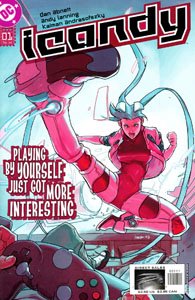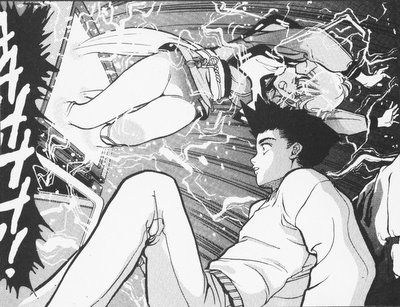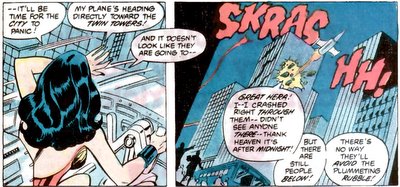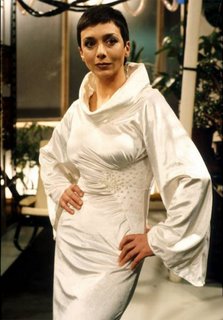Wonder Woman v1 269 - 286Okay, so by now you must be used to some odd changes of direction and ludicrous rationalisation, but grab some asprin because this next bit is going to make your head hurt.
In a big shake up that I can only assume was ordered by those in charge to try and get Wonder Woman back on the rails, issue #269 begins a storyline that once more throws out baby, bathwater, bath, and assorted plumbing fixtures in a storyline reminiscent of #204. At least nobody gets shot by a random sniper this time.
Wonder Woman is feeling depressed and so decides to unwind watching TV. Unfortunately her choice of viewing appears to be either a 24 hour news channel or one of those "
World's Hundred Greatest attrocities" shows and the result makes her more miserable than ever. Deciding that she's had enough of man's world, she hops in her invisible jet and flies home to mother.
Queen Hippolyte sees what a state she is in and assumes that she is still moping over the twice dead Steve Trevor and so prays to Aphrodite to make WW forget she ever met him (1). Aphrodite agrees suspiciously easily (2) and before you can say "
what's that strange purple smoke I'm sniffing?" Wonder Woman has forgotten she ever met Steve Trevor and presumably the large chunks of her life he featured in and is all happy again (3).
But then, just as Hippolyte believes everything is nicely sorted, an aircraft crashlands right next to her trireme (4) and wouldn't you just know it? It's a Steve Trevor from a parallel universe. Aphrodite pops up again to explain who he is but fails to mention
why he just happened to fall through a dimensional hole in order to crash 10 feet away from Wonder Woman, thus enabling her to rerun her origin, or why Aphrodite never mentioned this in the previous issue when she helped Hippolyte erase WW's memory. It is clearly part of the same scheme, and poor Hippo is just left looking like an idiot (5). So it's out with the mists of Nepenthe again, only this time they must be using the economy size box in order to rewrite the memories of everyone on the planet who has ever heard of Wonder Woman or Steve Trevor.
Does this qualify as a retcon? I think it does. The universe has been magically reprogrammed so that parallel universe Steve Trevor has always been a member of the U.S. air force of
this world and is shown as being in charge of ongoing projects that have been running for some time, so Aphrodite's spell is not just affecting people's memories, it is altering the past to accomodate the new status of our heroes. Diana Prince is now a captain and his adjutant. Etta Candy reappears again as Diana's secretary (6). The amazon princess is now so brain damaged from all this memory erasing over the years that she can't even remember that she was in the army for over two decades

Wonder Woman goes out clubbing with Steve in full Wonder Woman costume (7) but fails to attract any attention (8) until the tedious Angle Man (9) shows up to spoil her date. But he's just the warm up act. The real plot begins in #274 with the introduction of Kobra as the lastest in a long line of secret organisations out to blah de blah de waffle world domination waffle blah.
Oh my god will someone play a different tune for a change? They've been playing this same cracked record over and over for years now. At least Doctor Cyber had style until she went mad. But they've recycled this same plot half a dozen times one after the other and this dead horse ain't getting any fresher for each new flogging.
Issue #274 also revamps an old WW villain, the Cheetah. There's even a helpful editorial note to remind readers that she was last seen in #230. Very handy, except that #230 was one of the Earth 2/World War 2 issues, and so cannot have anything to do with the current storyline. In fact the last time
THIS Wonder Woman met the Cheetah was in #166, way back in 1966
For some reason writer Gerry Conway feels the need to have Pricilla Rich (10) die of some unspecified illness so that her neice Debbi Domaine can be brainwashed by Kobra into wearing the costume while acting as an eco-terrorist. I see absolutely no point to this. Why bother to reintroduce an old villain if you are going to revamp them to the point where they bear no resemblence to the original? Why not just make a new one? In context it would have made more sense for Debbi to be brainwashed into becoming an eco-terrorist (11) on purpose rather than grabbed as a kind of consolation prize when the kobrettes couldn't get Pricilla.
In fact it would have been a much more interesting plot twist if Debbi had just taken the identity of the Cheetah without reference to Pricilla at all. That way you could have Pricilla come out of retirement to confront the person who had stolen her identity. What a waste.
Of course it does allow for the ludicrous opening scene of #276. Wonder Woman sneaks into Pricilla's funeral looking for clues. Luckily Kobra are filming the event (12) and so WW gets to chase the cameraman, who blows himself up to avoid capture because people who make home movies of funerals are just
that hard.

Having failed to get snapshots of Pricilla getting planted, Kobra move on to more serious matters and steal a specially evil nuclear bomb that the air force had been building and which Steve Trevor had been overseeing for months, despite having only been in this dimension for a week or two. When Aphrodite casts a retcon spell she doesn't mess around. And then it's back to fantasy physics as Steve explains just how nasty the bomb is.
In fact the basic idea he outlines doesn't seem to be too far into lala land. His use of the term "cobalt 93" initially made me think he was talking about a nonexistant isotope, although he does claim this is a "code name", so perhaps he actually means Cobalt 60, which would be used in the kind of dirty bomb he's talking about. The "93" apparently refers to the number of years the affected area would remain radioactive, which is awfully specific of him, particularly when he seems so vague about everything else to do with it.

The big booboo here is that dirty bombs are not strictly nuclear bombs. In a nuclear weapon the radioactive material is made to fission, which causes the explosion. The more material that fissions, the bigger the bang, the less radioactive material there is spread around the countryside. In a dirty bomb the whole point is to spread as much radioactive material around as possible and the bang is just the delivery system. Consequently the current definition of a dirty bomb is usually one where the actual explosives are non-nuclear and are only used at all as a way of dispersing the radioactive material into the atmosphere. Early nuclear bombs only included a "dirty" aspect because they were innefficient and failed to cause all of the radioactive material in them to fission.
Then just as Steve is explaining what this top secret project is to unspecified bigwigs at the Pentagon, King Kobra makes a worldwide broadcast to blackmail the world's governments with this device that apparently even the Pentagon didn't know about until just now. Presumabably everyone thinks he's a crank in a snake hat because no other superheroes make any effort to stop him.
Luckily Diana Prince's landlord gives her a tip on the Kobra cult (13) that leads her to generic psychic (14) Mother Juju, who gives her a history lesson about how the original cobra cult was responsible for ending british rule in India (15) and having suceeded in that they got a bit power happy and now want to rule the entire world (16). This gives our heroine the idea that the main Kobra base may be in New Delhi, so off she goes.
Arriving in an embarrasingly cliched representation of India staffed entirely with orange skinned people in robes, she immediately locates the secret Kobra base but falls down a hole and twists her ankle like a total girly so she can be caught by Kobra. But after a quick fight with a giant robot snake she escapes, of course.
Meanwhile Steve is now talking about "cobalt 93 isotope" and explaining the plot to Diana Prince before going off on a rant that shows his grasp of politics is as great as his understanding of nuclear physics, but it seems to fool Diana.

We next find that Kobra have fitted the cobalt 93 bomb into an army surplus ICBM (17) that they've installed in the great pyramid of Cheops in Egypt without being spotted by tourists. Wonder Woman arrives and of course is immediately caught by Kobrettes who have no clue who she is. Apparently they didn't get the memo.
At least this distracts them from noticing Steve climb into the missile and reprogram the guidance system by ripping out some wires. It's effective though, and he manages to guide it to a non-explosive splashdown in the Arabian Sea where Wonder Woman can pick him up after the great pyramid of Cheops blows apart when she hits some control panels.
With #279 we get a change of pace as Etta Candy is kidnapped by demons living in the apartment below (18). A little hocus pocus from Mother Juju (19) sends Wonder Woman off to investigate a military project to summon demons, but after a lot of running about it all turns out to be complicated plot by Klarion the Witch Boy to trap Etrigan the Demon. It doesn't work.
And then it's back to yet another secret organisation, but this one is chinese and just wants to return the world to a feudal state. Oh yes, that's a realistic ambition all right. They've even got a robot dragon and a U.S. army surplus missile (20).
After wading through all this tedious, repetitive, cliched, derivitive dreck, issue #286 comes as something of a shock. It's the story of a failed actress who desperately wants to achieve something in the few months she has left before she dies of cancer. It rises above sentimental cliche by the clever trick of being better written than any Wonder Woman story for the best part of a decade. And the biggest twist of all is that such a touching, human story was written by Robert Kanigher.
And I'm going to stop there, because I have a nasty suspicion that next issue we'll be back in the poo.
Next:
The trademark police hit town.Notes
The majority of this article was written back in September but the comics of this period are so dire that I couldn't work up the enthusiasm to finish it. The next part will be sooner in coming.
1. seems like Hippo's first choice for any problem is to make everyone forget it happened
2. she's read ahead on the plot
3. wait, what about all the other stuff that was depressing her?
4. yes, the amazons have an advanced space program, submarines, and their own airforce, but when they want to investigate potential threats to the safety of their island, they go in a trireme.
5. that'll teach her to ask a favour of such capricious deities
6. last seen in the same job during World War 2 in the Earth 2 issues
7. plus the cape from the TV show
8. no paparazzi in 1980, apparently
9. his appearances in Wonder Woman since #227 have involved him showing up and being annoying, getting beaten by Wonder Woman and then having his Angler weapon destroyed. And yet somehow it's always magically fixed the next time he turns up even though it is Apokolips tech and he has no idea how it works
10. the original Cheetah
11. she had already been introduced as an ecological activist so it would just be taking her views to the extreme
12. Why? What possible use could it be to them? Someone please explain this to me because it makes no sense as far as I can see.
13. how handy
14. more of a large than a medium
15. yeah, right.
16. Funny, but none of the Kobrettes we've seen so far have shown any evidence of being indian.
17. InterContinental Ballistic Missle.
18. no wonder the rent was so reasonable. Poor Diana doesn't have much luck with neighbours.
19. plot devices a speciality
20. do you think they shop at the same place as Kobra?
 Everyone hates Zatanna's centipede hat. It's the crowning glory of a terrible costume design that entirely fails to fit her character or powers in any way. And yet in other circumstances it might work. For instance, if worn
Everyone hates Zatanna's centipede hat. It's the crowning glory of a terrible costume design that entirely fails to fit her character or powers in any way. And yet in other circumstances it might work. For instance, if worn  by the captain of an evil puppet spaceship, with the centipede so far forward that it got in their eye.
by the captain of an evil puppet spaceship, with the centipede so far forward that it got in their eye. And then there's the original costume worn by The Wasp when she first appeared. If you ever wondered what trauma caused Janet Van Dyne to become obsessive to the point of wearing a new costume in almost every issue of The Avengers, it can now be told. It was the hat. The one shaped like a wasp's sting. Of course, a wasp's sting isn't on the top of its head.
And then there's the original costume worn by The Wasp when she first appeared. If you ever wondered what trauma caused Janet Van Dyne to become obsessive to the point of wearing a new costume in almost every issue of The Avengers, it can now be told. It was the hat. The one shaped like a wasp's sting. Of course, a wasp's sting isn't on the top of its head.


































